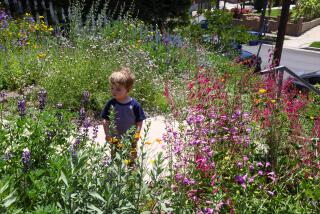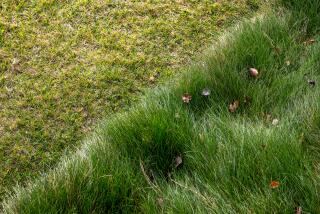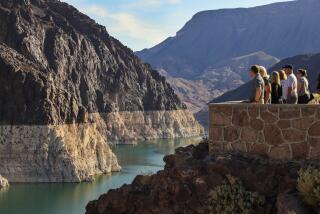A Sprinkling of Advice for Hot-Weather Watering
- Share via
Not much goes on in the garden during these hazy, lazy days of summer, except watering, of course. And since no one rule applies to every plant or every part of the garden, watering requires considerable thought--and even then it is often a puzzle.
Lawns require the most water, but different kinds of grasses require different doses. The most common lawn grass in Los Angeles is Bermuda grass, which many people mistakenly call crabgrass (crabgrass has much wider blades and tends to grow as a flat, ground-hugging clump) or devil grass (its name back East). Bermuda grass has very narrow blades and is usually mowed very close to the ground. It goes dormant or nearly so in winter but should look its best right about now.
Bermuda grass is undoubtedly our toughest lawn grass and it can get by on very little water. A healthy Bermuda lawn shouldn’t be watered very often, perhaps once or twice a week, but it should be watered deeply because the roots are capable of growing several feet into the soil.
Dry-Chamois Effect
Most Bermuda lawns, however, have built up such an accumulation of dead runners that the roots no longer grow very deep, and may be in the top few inches of soil. A lawn in this shape will need more frequent watering. If you suspect that the water isn’t soaking in, you can try turning the water off and on, off and on, and so on, until it finally does. It’s much like trying to wet a dry chamois.
Another way to wet a lawn that has become so dry that it resists water like an oil-soaked rag is to use one of the soil penetrants. These are wetting agents that help the water soak in. Most often they are sold mixed with a liquid fertilizer, which certainly won’t hurt. Germain’s Pentrex is one such product.
The other common grasses--the ones usually planted as sod--are the cool-season grasses, which aren’t enjoying the weather right now at all. These do not creep or have runners and are usually mowed much higher than Bermuda. These grasses, which include the many kinds of bluegrass and rye, need much more frequent irrigation because they are shallow-rooted.
Now, in the middle of summer, they may need to be watered every day, but for a short duration--5 or 10 minutes may be enough. My experience with the new tall fescues that are supposedly drought-resistant is limited, but my own seems to have watering needs somewhere in between Bermuda grass and bluegrass. It needs water at least twice a week.
Root Growth Takes Time
Things that were planted this summer or spring will need frequent watering, even those that will eventually be drought resistant, including California natives. Their roots have yet to grow very deep into the soil (most root growth occurs in the autumn months) so they are very dependent on the gardener. Small bedding plants will need to be watered almost daily; young trees and shrubs will need water twice a week.
Other trees and shrubs, which have been growing in the garden for more than a year, can get by on monthly irrigations, but they must be thoroughly soaked at that time. If sprinklers are assigned this task, they must be left to run for an hour or more; better yet, build a watering basin by mounding soil in a circle and then flood it several times.
Several shrubs and trees need more frequent watering, notably all fruit trees but especially citrus, azaleas and camellias (which are making next year’s flower buds), roses (which grow and flower all summer), and hydrangeas (which simply need lots of water).
The fruit trees should be watered about every two weeks and the rest should be watered like they were garden flowers. I manage to water only once a week, but I do so thoroughly. All of the annual flowers and perennials and the shrubs that grow among them get one thorough weekly irrigation.
Southland Mini-Climates
The spacing of these waterings, and how long the water is let run, varies considerably from garden to garden and from one side of town to the other.






